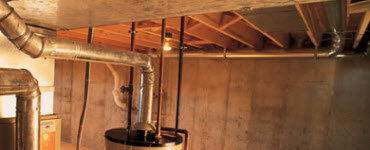Weatherizing tips & tricks
Exterior weatherizing
The primary areas to seal with caulk are:
- The top and bottom edges of the rim joist - this is the thick wooden board that site on top of the concrete foundation and connects to the floor joists.
- The outside edges of windows and doors. Don't forget the basement windows!
- Any opening on the wall of your house, including water spigots, electrical outlets, air conditioner hoses, dryer vents, and gas and water pipes.
If you find a large hole or crack, use expanding foam. A small squirt is usually enough to seal the opening - too much can damage the surrounding materials. Don't use expanding foam around any electrical equipment.
If you have storm windows, use them. If you don't, install plastic window film, especially on north-facing windows. Don't forget to cover basement windows too.
Weatherizing your windows
- Apply caulk around the outside edges of the window casing.
- Apply glazing around the edges of the windowpanes. Scrape off old glazing and clean the glass; when it's dry, apply the glazing where the glass meets the window frame. Press it tightly and smooth with a putty knife.
- If you have double-hung windows, open the bottom sash and install adhesive-backed foam weatherstripping to the tracks and to the bottom of the sash.
- Close the window tightly and use rope caulk to seal all the moving parts.
- If you don't have storm windows, install window film, either interior or exterior. Apply the tape around the outside edge of the window, apply the film and shrink it tight with a hair dryer.
- Heavy drapes or curtains can also help hold back cold air, but remember to open them on sunny days to take advantage of the sun's rays.
- Don't forget to caulk around the outer edges of basement windows and cover them with plastic film. Don't use permanent caulk to seal basement windows shut - you may need quick ventilation in the event of a gas leak or carbon monoxide problem. Use removable rope caulk instead.
Weatherizing your doors
- Apply caulk to the outside edges of the door casing.
- Open the door and install weatherstripping to the inside of the doorjamb.
- If the door has a window, apply glazing or clear caulk to the edges of the windowpane.
- Stop under-door drafts with a rubber or vinyl door sweep along the bottom. In a pinch, a rolled-up towel can work too.
- Replace the threshold under the door with a flexible vinyl gasket. Look for an adjustable model that's easy to fit to the proper height.
- If you have a side or basement door you rarely use, seal the edges with removable rope caulk.
Other areas to weatherize
- Electrical outlets, especially along exterior walls, are a prime spot for cold air drafts. Carefully unscrew the cover and press a foam gasket around the sockets. Put the cover back on and insert childproof safety caps into all unused outlets.
- The attic opening is another drafty spot. Install insulation over the back of the attic door; if you have hatch-type access, add foam weatherstripping around the top edges of the openings.
- Wood fireplaces are notorious sources of air leaks. Tight-fitting glass doors are the best way to prevent air from escaping or entering. When you're not using the fireplace, keep the damper closed and close the glass doors tightly. If you never use the fireplace, plug the chimney with insulation and seal the doors shut with silicone caulk.
More from this category
Spray foam insulation
Spray foam insulation does a great job of sealing up cracks and crevices, if it's installed properly. Learn more about open-cell spray foam options.
Insulation options
The right insulation material for your home depends on where it will be used and what type you already have.
Insulation tips & tricks
Solar attic fan
Basements and crawlspaces
Insulating your new house's basement up to R-10 can help reduce energy costs by up to 12 percent.
Weatherizing materials
A typical home will need about $50 in weatherizing materials - and the cost can be paid back in energy savings in just a few weeks.
Vapor barriers & ventilation
An energy-tight home requires adequate ventilation and vapor control to maintain healthy air.








